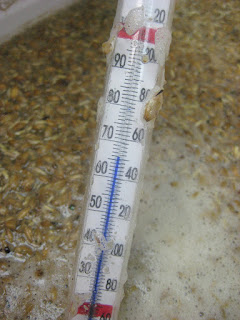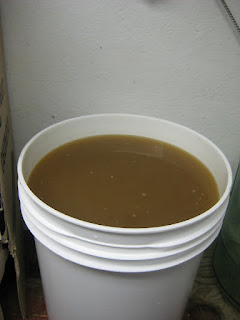Source - Haus Pale Ale
RECIPE
5.5 gallon batch (conversion to 6.5gallon and other changes in red)
Grain Bill:
8 lbs - 2-Row Pale Malt (4.3kg 2-Row Pale Malt)
2 lbs - Vienna Malt (1.1kg Munich Malt)
0.5lbs - Crystal 10L Malt (0.27kg Carastan15L)
Hop Schedule:
1.0 oz Cascade (60min) 34g
0.5 oz Cascade (30min) 17g
0.25 oz ascade (15min) 9g
0.25 oz Cascade (5min) 9g
1 Whirlfloc Tablet (15min)
Nottingham Yeast
Ferment in Primary for 10 days @ 68F (7 days Primary, 7 days Secondary)
5.67kg of grains (12.5 pounds)
Hops, Yeast, and Whirfloc
The grains needed to be mashed at 152F for 60 minutes, and I had to account for heat loss. I anticipated 10-12 degrees loss to the cooler walls and another 11 degrees to the grains, therefore, my strike water had to be heated to 175F. Using 1.35quarts of water per pound of grain, I used 15.5L of mash water. The water was heated to 175F and poured into the cooler. I closed the lid and the temperature rapidly dropped. In order to make sure I hit my mash temperature of 152F, I would have to Dough-In at 163F (anticipating 11degree loss to grains. The grains were added and I mixed well until the temp hit 152F - I closed the lid and covered the cooler with an electric blanket and covered that with a fleece blanket just to be sure.
Heating 15.5L of strike water to 175F
Dough-In at 163F - I can't believe how amazing this smelled
Lid closed and covered up with electric blanket and Maple Leafs fleece. (I'm praying for playoffs this year)
Electric Blanket set to high
After 60 minutes, I opened the lid of the MLT and was very pleased to see that I was able to hold steady at 152F for the full hour. The mash was left for another 8 minutes while the mashout water was continuing to be heated. I calculated Sparge water at 1.33quarts per pound which worked out to 14.5L, this left me with 5.5L of water for the mash out. The total water used was 35.5L, this accounted for a volume of 6-7L to be lost to the grain and to the boil off. My calculations were correct because in the end I nailed the volume for the fermenter dead on! The 5.5L were added to the mash at 175F and stirred in, I let this sit for 5 minutes before vorlauf and collecting the first runnings. My understanding of the mash-out is to mainly bring up the temperature of the wort to allow it to flow easier out of the Mash / Lauter tun. Vorlauf is the process of clarifying the wort, I simply pour into a pitcher when the valve is first opened until the wort begins to run clear. This pitcher is then poured back into the MLT while the first runnings are being collected.
The mash held at 152F for the full hour
Vorlauf - drain the wort into a pitcher until it begins running clear
Vorlauf - returning the collected cloudy wort to the MLT (we wouldn't want to waste any sweet delicious wort)
Collecting the first runnings
When the MLT was finished draining, the valve was closed and the 14.5L of 175F Sparge water was poured in, mixed well, and the lid was closed for 10 minutes. I then began vorlauf and collected the second runnings. The wort was boiled for 60 minutes and the hops were added per the schedule. With 15 minutes left in the boil, the wort chiller was dropped right into the boiling wort (this will sterilize the chiller) When the boil was complete, cold water was run through the chiller and the wort cooled from boiling to 80F in less than 10 minutes. I transfered it to the primary, pitched the yeast, and added a blow off tube. I took a gravity reading and came in at 1047, which is only 4 points below my target. I'm pretty happy about being that close on my first all grain brew!
Compacted grain bed after first runnings were collected.
Close up of the grain bed - mmmmmm.
Wort chiller dropped into the brewpot with 15 minutes left
Primary fermenter with a blow off rigged up.
Gravity reading of 1047!
Over all my first all grain brew day was a success even though I did have trouble with my propane burner. I had trouble heating the water as well as maintaining the boil. I fear the boil inconsistency will affect the hop utilization negatively. I started my brew day at around 7PM, and at about 1AM and many beers later, it was complete. i will have to investigate what the issue is with the propane burner before my next brew day, which hopefully wont take nearly as long.








































